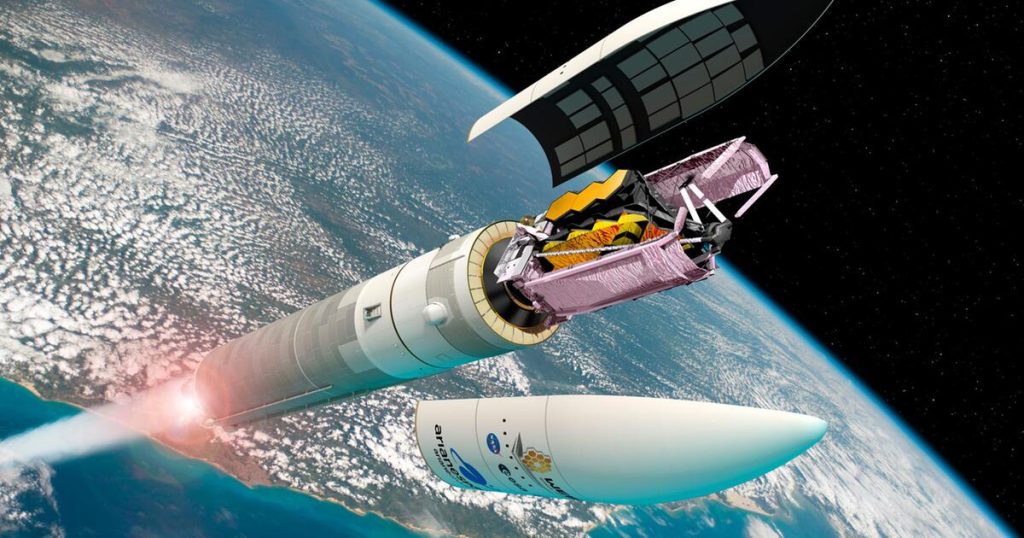Updated Dec 15, 2021 at 7:11am
- Decades of planning, cost bangs, delays and then there was also controversy over the name.
- The process of creating James Webb was long and rocky.
- But now the largest and most powerful space telescope is about to be launched.
Astronomers and space engineers around the world have been working and excited about the day for decades: on Wednesday (December 22), the James Webb Space Telescope (JWST) is supposed to truly blast off into space after many twists and turns—and that’s not only just Another space telescope, it’s about the undisputed star of the fleet, says Jane Rigby, NASA Administrator. “Webb is so transformative that I suppose it will mark a new era – there will be a time before and a time after.”
The cost of the successor to “Hubble” was about ten billion dollars
JWST is a nearly $10 billion collaboration between space agencies in the USA, Canada and Europe, and when it launches from the Kourou spaceport in French Guiana, it is set to become the largest and most powerful telescope ever launched into space. It is planned that it will be the successor to the “Hubble” telescope, which has been in use for more than 30 years, will fly 1.5 million km into space and, among other things, will provide new images from the early universe with the help of a 25 square meter mirror. The telescope is supposed to observe the first galaxies that formed after the Big Bang.
However, the previous trip of the giant telescope was so long and rocky that the specialized magazine “Nature” wrote about “the most expensive astronomical hazard in history.” The idea for this telescope first appeared at the end of the 1980s, and planning and construction have continued since then. Small accidents occurred again and again, planning was delayed, and costs originally estimated at $500 million. In 2007, JWST was originally supposed to start – but the start has always been delayed, recently because the mounting tape came out unplanned.
There is also controversy over the name referring to the second director in the history of NASA back. Webb was the head of NASA in the 1960s — at times when the agency sent the first humans into space, but also at times when an employee was fired on suspicion of being gay. Several scientists have already called for the renaming, but current NASA chief Bill Nelson has rejected it so far. “At this time, we have not found any indications that a name change was necessary.”
Many scientists hope that a successful start will put all these controversies in the background — and pave the way for unprecedented research opportunities. They hope to go back to the early days of space after the Big Bang 13.8 billion years ago: to images of stars older than our solar system and may no longer exist — and perhaps even to evidence of a second Earth.
After the start, the telescope must be in the correct orbit
After takeoff aboard the Ariane launcher, the path to target orbit should take about four weeks, taking months to cool down and open the massive mirror and a tennis court-sized sun protection system using about 130 individual mechanisms. The first tests will likely take about seven months, and the first images are expected in the summer at the earliest. While Hubble works in the optical and ultraviolet range, James Webb looks in the near infrared. Astrophysicist John Mather once said that a telescope could even “track a bee on the moon from Earth.”
James Webb’s life was initially set at ten years, then he would run out of fuel, so to speak. The fact that the telescope flies so far also carries risks: while Hubble has been repaired and serviced several times with shuttle flights at an altitude of 500 km, the James Webb Space Telescope is no longer operating at a distance of 1.5 million km.
Astronomer Heidi Hamill, who has been developing the telescope for decades, says the excitement at the start now reigns. “There aren’t many things in life where you are on the cusp of something this big. There are so many emotions involved.” (dpa/mgb)

“Total coffee aficionado. Travel buff. Music ninja. Bacon nerd. Beeraholic.”









More Stories
Coral Seeding: Artificial Insemination Makes Coral More Heat Tolerant
Fear, Anger, and Denial: How People Respond to Climate Change – Research
LKH Graz: Using radiation to combat heart arrhythmias